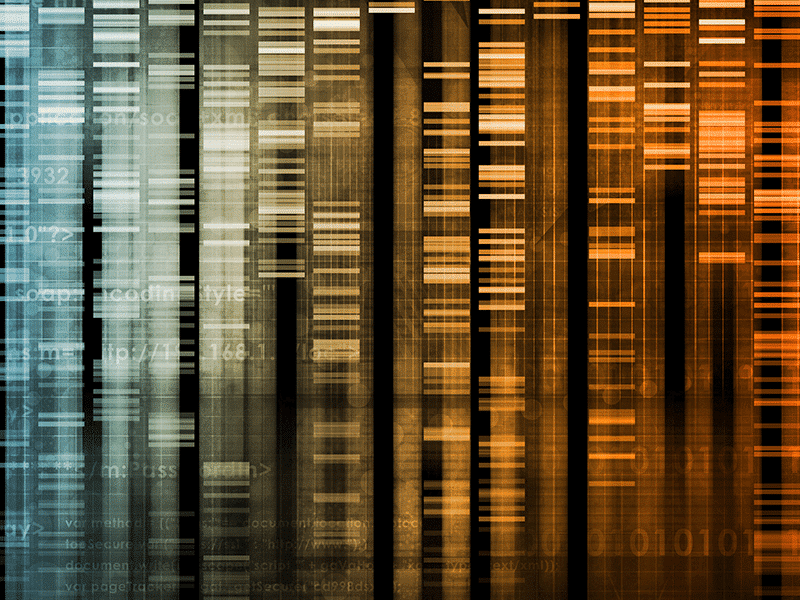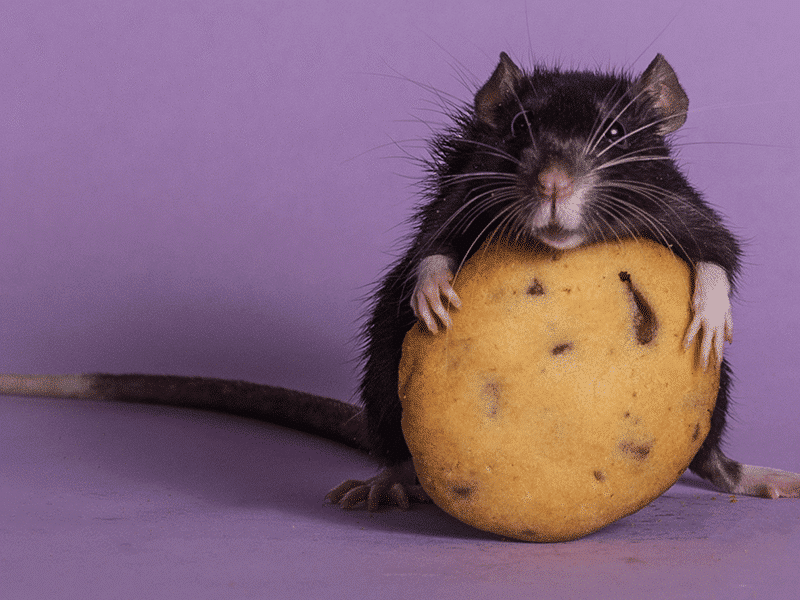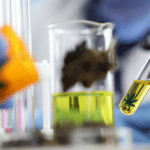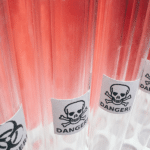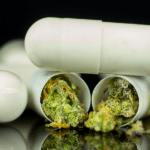The research is in. Scientists have discovered a cure for cannabis addiction — and it turns out to be cannabis! That was the gist of a headline-generating paper published in JAMA Internal Medicine, a Journal of the American Medical Association, which wasn’t trying to be satirical.
The July 2019 report, titled “Nabiximols for the Treatment of Cannabis Dependence: A Randomized Clinical Trial,” described an Australian study that probed the use of a standardized cannabis extract for treating cannabis dependence.1 The extract, called nabiximols (and marketed under the brand name Sativex), is an ethanol-based sublingual spray containing roughly equal parts THC and CBD, which has been approved for treating multiple sclerosis in many countries around the world.
The researchers hoped to show that this particular pharmaceutical formulation of cannabis would stop participants from smoking marijuana. Of course, the research would also need to show that nabiximols actually improves the quality of life of people trying to wean themselves off weed — rather than just changing their source of THC.
Replacement Therapies
The practice of treating drug addiction with other drugs is nothing new. Nicotine replacement therapy (NRT) – utilizing a patch, gum, lozenge, etc. – can help to ease cravings for tobacco without inhaling all the toxic smoke. NRT isn’t perfect, but it can be a useful harm reduction technique.
Not all formulations are equal, even those comprised of the same drug. E-cigarettes are not considered a valid treatment for tobacco smoking in the United States, thanks to a handful of studies suggesting E-cigarettes are considerably less effective than other NRTs and can act as an entry point for teens to start using tobacco.
Opioid replacement therapy is another common practice in clinics. Methadone and buprenorphine are both highly addictive, but getting a heroin addict onto a legal supply of consistent, unadulterated opioids can save lives.2 Replacement therapies are a double-edged sword, however. After all, heroin was considered a treatment for morphine addiction in the late 1800s.
Eager to find a replacement therapy to facilitate cannabis cessation, the National Institute on Drug Abuse and other institutions have been funding research into medication-assisted treatment for marijuana dependence. Thus far, no meds have been approved for this purpose, but not for lack of trying.3
A Red Flag
At first glance, the 2019 JAMA article may seem like a regular study seeking to test a potential substitute medication for marijuana. As a randomized clinical trial, the Australian study was pre-registered with the hypothesis and methods laid out before data collection began.4
In their trial, the Australian researchers listed three primary aims and a handful of secondary aims of the clinical trial, along with the statistical methods that would be used to analyze the data. The primary goals were to compare nabiximols to placebo in three ways:5
- Would nabiximols improve abstinence from cannabis use, compared to placebo? Reductions in the frequency of use?
- Would nabiximols affect treatment retention?
- What are the side effects of nabiximols, compared to placebo?
They described the first question as follows: “Unsanctioned cannabis use will be quantified as 4-weekly point prevalence abstinence during the 12 week maintenance phase by combining self-report data from researcher interviews … with objective measures of unsanctioned cannabis use (weekly UDS [urine drug screen] with quantitative analysis of urinary THC, CBD and their metabolites). Unsanctioned cannabis use will also be reported as mean days used, and percentage of positive urine drug screens.”
This registered aim should have immediately raised a red flag, given that nabiximols (Sativex) is a formulation of cannabis. The THC and CBD in nabiximols is not chemically different from the THC and CBD in “unsanctioned cannabis.” So, all clinical trial participants who receive nabiximols would test positive for marijuana, according to the usual “objective measures.” Practically speaking, this means that assessing whether the first goal had been achieved would be limited to self-reporting, rather than a urine analysis.
The registration for the study went up in early 2016, followed by over a year of patient recruitment. Slightly less than half of all recruited patients completed the full 12-week abstinence program. Afterwards, the researchers analyzed the data and wrote up the results, which were accepted by JAMA in April 2019.
But, come publication, the study referred only to a single primary outcome, rather than three. What happened to the two other outcomes that were promised when the study was registered?
Moving the Research Goalposts
This discrepancy — between the three registered goals and the single published outcome — was first pointed out by Stanford doctors Robert Kleinman and Michael Ostacher in a letter to JAMA Internal Medicine.6
In “Nabiximols for the Treatment of Cannabis Dependence,” Lintzeris et al repeatedly describe the primary objective of their research: “The primary hypothesis for the study is that a 12-week treatment program with nabiximols will result in significantly less illicit cannabis use…”
According to the Australian authors, “The primary end point was self-reported total days of illicit cannabis use during weeks 1 to 12…”
They even go so far as to disavow their registered plan to use abstinence as a primary outcome: “Previous studies of treatment for cannabis dependence have reported on abstinence rates, and this outcome (while not the primary end point in this study) was used to estimate a sample size of…” [emphasis added].
What was lost between the study’s design and the data analysis? What primary goals were dropped or reframed as less important, and why?
For one, the discussion of adverse events was minimized. There were no statistical differences between the adverse event profiles of nabiximols and the placebo, though the reader would need to download tables of supplementary data to see the specifics, a handful of which are jammed into a single paragraph describing the side effects of the treatment. Nabiximols didn’t appear to cause more side effects than taking a placebo spray, but there were not enough participants to analyze specific problems.
One interpretation of this result is that nabiximols treatment – on average – neither produced nor reduced cannabinoid-related side effects.
The other primary question that got swept under the rug pertained to treatment retention. Poor retention often foreshadows a failed pharmaceutical. If the study participants are giving up on the treatment, then it’s unlikely to succeed as a medicine. In both the placebo and Sativex groups, slightly more than half of the participants dropped out. This dropout rate is fairly typical for studies on cannabis dependence. Only three sentences in the JAMA article address what was supposed to be one of the key outcomes of the study; the authors mention in passing that the treatment didn’t significantly affect retention.
In other words, what turned out to be two non-significant outcomes and a one positive self-reported outcome was presented in JAMA as a single positive result. And even this lone positive result appeared doctored from its original intent, with abstinence no longer recognized as the aim of their treatment for cannabis addiction. It’s hard not to suspect that the authors were spinning their report to inflate the significance of the paltry results.
Hedging Their Bet
It’s worth asking why this matters in the first place. It may seem a bit dodgy to change the hypothesis of an experiment after the fact, but that doesn’t necessarily mean the data isn’t valid. Nor does it mean that their conclusions can’t be right. Isn’t science supposed to be objective, regardless of a researcher’s intention?
Unfortunately, the problem is a lot bigger than just data. Fiddling with a hypothesis after the research has been conducted fundamentally compromises the scientific process itself. The scientific method uses experiments to test ideas and better understand the patterns that emerge in nature. But that’s not the same as just pointing out what patterns happen to exist in a given data set. Hindsight is 20/20, and it’s easy to find trends after the fact.
Post-hoc hypothesizing is so tempting and so common among researchers that it’s gotten a name for itself: “HARKing”, or Hypothesizing After the Results are Known.7 This retrospective thinking lets people reframe their hypothesis to appear correct, rather than actually testing a model scientifically.
Oftentimes, HARKing allows researchers to disproportionately emphasize parts of the experiment that look “good” by some standard. That tends to mean flashy, positive results that draw more excitement, funding, and attention to their research. Positive papers are much more appealing than ones finding no association or replicating a result that had already been discovered. It’s one of the many features of publication bias, which tends to promote positive results while suppressing unwanted or nonsignificant findings.
Some 30-50% of scientists admit to engaging in these post-hoc hypothesis adjustments, according to surveys.8
A Lame Reply
Kleinman and Ostacher’s letter goes on to mention other questionable statistical maneuvers in the JAMA study on cannabis addiction, such as the apparent failure to correct for multiple comparisons in the Australian clinical trial. Often called p-hacking,9 multiple comparisons is the practice of testing extra associations to find any positive result – it greatly inflates the likelihood of false positive results.
JAMA Internal Medicine published Kleinman’s critique alongside another letter about the study, as well as a response from Lintzeris and two other co-authors.1011 Editors typically give authors the chance to respond to criticism of their article. But Lintzeris’s response does not even acknowledge the removal of two of the study’s three primary end points, which undermines their credibility.
Instead, while neglecting these serious concerns, the reply focuses on doubts about the single primary outcome that the authors had presented.
In addition to the other criticisms raised, the Stanford doctors took issue with how the first primary outcome was initially described. The final publication focused on how treatment affected the frequency of cannabis use — not on the likelihood of abstinence from cannabis. That’s a key difference.
According to the registered protocol, both metrics should have been incorporated, but the publication only described the successful outcome (an average decrease in the number of days cannabis was used) as a primary result. Abstinence was demoted to a secondary measure. And the fact that nabiximol treatment didn’t increase abstinence from cannabis was buried later in the article.
In their rebuttal, Lintzeris defended reframing their single primary outcome, while still ignoring the fact that they had pre-registered three primary outcomes, not one. They suggested that the emphasis was unimportant because the results were presented elsewhere in the paper, saying, “Both self-reported days used and the proportion of patients self-reporting abstinence at 4-week research interviews are transparently reported in the article, enabling readers to make their own conclusions. We make no claims that nabiximols is effective in achieving abstinence at a greater rate than placebo.”
The second half of the letter then continues to defend the measurement of reduction in use rather than full abstinence in response to another letter, leaving many issues unaddressed.
Fudging the Facts
Randomized clinical trials are held up as an ideal form of scientific evidence. But not every report is equally credible. An honest case study is more valuable than a misrepresented clinical trial. Many experiments bearing negative or disappointing results never see the light of day, which may be why nearly a third of US-based clinical trials don’t get reported.
Positive results aren’t always what they appear to be, either. In another 2019 study, for example, scientists at Harvard and Yale described their efforts to treat cannabis addiction with galantamine, a drug for Alzheimer’s dementia. After finding the treatment had no effect on cannabis addiction, they somehow assert that their data “support the feasibility of the administration of galantamine for individuals with CUD [cannabis use disorder].”12
In the nabiximols study, it appears that the Australian researchers conducted a trial with mediocre results. But instead of presenting the experiment as it was designed, the researchers chose to misleadingly interpret their data to make the results look better.
Even the gold standard of medical research can be tarnished in the wrong hands.
Adrian Devitt-Lee is a research scientist and longtime Project CBD contributor. © Copyright, Project CBD. May not be reprinted without permission.
Footnotes
- Lintzeris N, Bhardwaj A, Mills L, et al. Nabiximols for the Treatment of Cannabis Dependence: A Randomized Clinical Trial. JAMA Intern Med. 2019;179(9):1242–1253. doi:10.1001/jamainternmed.2019.1993.
- Here, the need for replacement medication stems more from the risks of black market opioids than the safety of methadone.
- Many faux-cannabis product have been suggested, however: Would you give up a joint for 240 mg of isolated THC – twelve tablets of high-strength Marinol? (See “The effect of high-dose dronabinol (oral THC) maintenance on cannabis self-administration.”)
- Registration ID ACTRN12616000103460.
- Specifically, they listed:
1. “Unsanctioned cannabis use will be quantified as 4-weekly point prevalence abstinence during the 12 week maintenance phase by combining self-report data from researcher interviews (modified Timeline Followback recording number of days and average daily amount (grams) of cannabis use), with objective measures of unsanctioned cannabis use (weekly UDS with quantitative analysis of urinary THC, CBD and their metabolites). Unsanctioned cannabis use will also be reported as mean days used, and percentage of positive urine drug screens.”
2. “Treatment retention (days in protocol treatment). This will be assessed by the weekly clinical records review and research interviews.”
3. “Adverse events will be assessed by self-report using a structured symptom checklist at 4-weekly research interviews, and by clinical assessment with the study medical officer.” - Kleinman RA, Ostacher MJ. Clinical Significance and Outcomes in Trial of Nabiximols for Treatment of Cannabis Dependence. JAMA Intern Med. 2020;180(1):163. doi:10.1001/jamainternmed.2019.5667.
- See: Kerr, N. L. (1998). “HARKing: Hypothesizing After the Results are Known.” Personality and Social Psychology Review, 2(3), 196–217. doi:10.1207/s15327957pspr0203_4. See also: Munafò, M., Nosek, B., Bishop, D. et al. A manifesto for reproducible science. Nat Hum Behav 1, 0021 (2017) doi:10.1038/s41562-016-0021.
- Rubin, M. (2017, December 29). When Does HARKing Hurt? Identifying When Different Types of Undisclosed Post Hoc Hypothesizing Harm Scientific Progress. https://doi.org/10.1037/gpr0000128.
- The comic strip xkcd satirizes p-hacking quite well here. Or see, for example, “We’re All ‘P-Hacking’ Now.”
- The letter by Levin: Levin FR, Mariani JJ. Clinical Significance and Outcomes in Trial of Nabiximols for Treatment of Cannabis Dependence. JAMA Intern Med. 2020;180(1):162–163. doi:10.1001/jamainternmed.2019.5664.
- Reply by Lintzeris: Lintzeris N, Copeland J, Bruno R. Clinical Significance and Outcomes in Trial of Nabiximols for Treatment of Cannabis Dependence—Reply. JAMA Intern Med. 2020;180(1):163–164. doi:10.1001/jamainternmed.2019.5670.
- A review of clinical trials in 2018 and 2019 found that only 41% were compliant with the 2007 FDAAA law requiring that these trials are reported to the government within one year. Less than two thirds of trials were ever reported. See “Compliance with legal requirement to report clinical trial results on ClinicalTrials.gov: a cohort study” in The Lancet. doi:10.1016/S0140-6736(19)33220-9
- Devitt-Lee, Adrian. “Pharmaceuticals for Cannabis Addiction?” Project CBD, 28 May 2019, www.projectcbd.org/news/quick-hits/pharmaceuticals-cannabis-addiction.
Recommended Readings
Cannabis Science: What to Believe
Bias is baked into scientific research about cannabis. How can you tell what is worth reading, and what isn’t?
Spinning Research
Two contradictory studies underscores why preclinical research is only a first step.
Cannabis Hyperemesis Syndrome
What you need to know about the cyclic vomiting syndrome linked to cannabis use.




